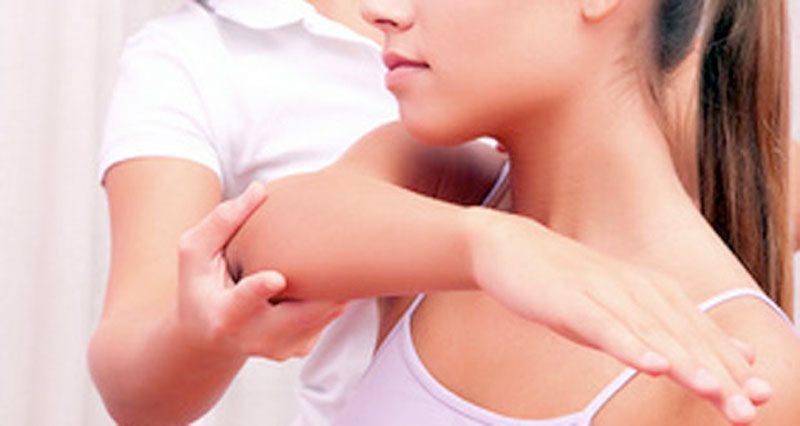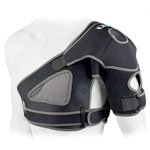Here we explain how a professional sports injury therapist might perform a shoulder assessment in order to diagnose a shoulder injury. They may begin with questions (subjective assessment), carry out a physical assessment (objective) and use specific shoulder assessment tests.
Subjective shoulder assessment
The following examples are for information purposes only. We highly recommend seeing a sports injury professional or Doctor receive a full assessment of your injury.
During a subjective assessment, information is gathered regarding the history of the injury to allow the assessor to build a complete picture of the injury. The following questions may be asked:
Have you suffered any previous injuries?
This is usually asked to determine if any previous injury to the Shoulder may have an effect on the current injury. Make sure you mention every injury, even those to the neck, elbow and upper back, no matter how small, it may still be useful information to your practitioner.
Do you currently take any medication?
This is usually asked in case the practitioner prescribes or recommends other medication (e.g. anti-inflammatories).
How did your injury happen?
Try to describe with as much detail as you can exactly what happened at the time of the injury. If it happened as a result of a traumatic event (fall, twist, direct blow etc) try to explain in which direction your shoulder went, on which part you landed or the direction the force came from. If the injury has gradually developed try to explain when you first noticed it, what you were doing, and if you have changed your activity level or training lately.
Have you received any other treatment?
The practitioner will want to know if you have taken any painkillers or anti-inflammatories if you have applied ice or heat or worn a support etc. They will also want to know if you have seen any other professional about it (a Dr, physio, sports therapist etc) and what treatment they gave you.
Describe your pain
It is important that the practitioner knows:
1. Exactly where the pain is
2. How severe the pain is (they may ask you to rate it 1-10)
3. If it’s constant or intermittent
4. If its a sharp pain, dull ache, throbbing pain etc
5. What activities/movements aggravate it
6. If the pain radiates (moves, or shoots)
7. If the pain is worse at certain times of the day
Do you ever feel tingling, pins and needles or numbness?
These symptoms can often (but not always) indicate the involvement of one or more nerves
Have you felt any other sensations?
Such as clicking, grinding, locking, instability or giving way.
Have you noticed any swelling or bruising?
If the time has passed between the injury first occurring and you seeing a specialist they would need to know if there was any swelling or bruising as this can indicate the severity of the injury.
Objective or physical shoulder assessment
This part of the assessment involves the practitioner looking at the shoulder itself, examining it and the joints above and below (elbow and neck/upper back). With shoulder injuries often what’s known as scapulohumeral rhythm is affected (how your shoulder blades move in relation to your arms), so your practitioner should also look for this.
Observation and Palpation
The practitioner will look at your shoulder, comparing it to the other side, for muscle definition, bony structures, colour, swelling, bruising etc. They will also palpate (feel) the muscles surrounding the shoulder and scapula for areas of tenderness and tension. They may also palpate the clavicle (collarbone) and scapula.
Range of Motion
They will next look at the movement available at the shoulder joint. Movements of Flexion (raising your arm in front) Extension (moving the arm backwards) Abduction (Moving the arm out to the side) Adduction (bringing the arm across the body) Internal and External Rotation should all be compared to the uninjured side.
All of this movement should be assessed in both active and passive motion. Active is where the patient moves the body part themselves (pain on these movements suggests muscle injury), a passive motion is where the practitioner moves the body part while the patient rests (pain here indicates tendon or ligament injury).
Resisted Muscle Tests
These can be performed to test muscle strength in comparison to the uninjured side and also to elicit pain (suggesting muscle injury). The assessor will ask you to push against some form of resistance, usually their hand or arm in various directions.
Shoulder assessment tests
For every body part, there are a number of tests which help the practitioner to confirm a suspected injury. The following can be used on the shoulder:
- Empty can (tinny) test: Hold your arm out straight in front of you with the thumb facing downwards. Raise and lower the arm (as if emptying a can!). Pain indicates injury to the Supraspinatus muscle or tendon.
- Neer’s Test: With your arm straight out in front and the thumb pointing downwards the practitioner with passively raise your arm above your head (if it will go this far pain-free!). A positive test indicates a rotator cuff impingement.
- Hawkin’s Test: This is a more sensitive test for impingement than Neer’s test. The practitioner will place the arm at 90 degrees of flexion and internal rotation (thumb pointing downwards) and then bend the elbow. They may then get you to push your arm upwards against resistance.
- Gerber’s Lift-off Test: Place the back of your hand on the lower back. Try to then lift the hand off the lower back Pain and difficulty in this movement indicate a tear of the subscapularis muscle. No pain but a complete lack of movement indicates a complete rupture.
- Drop-Arm Test: Fully abduct your arm so that you lift it out to the side and above the head. Then slowly and with a controlled motion return it back to your side. Difficulty in producing a smooth movement (with the arm ‘dropping’ back to the side) and pain in returning the arm back to the side indicates Supraspinatus muscle injury.
- Apprehension Test: The practitioner asks you to lie down and will passively abduct your arm to 90 degrees with the elbow bent. They will then externally rotate the shoulder. The apprehension test is positive if this feels uncomfortable or as if the shoulder will pop out of the socket. Anyone who has recently had an anterior dislocation of the shoulder joint or has anterior instability will find this position uncomfortable.
- Crank Test: The arm is abducted to 90 degrees with the elbow also bent to 90. The practitioner pushes on the elbow, pushing the humeral head further into the joint whilst rotating the shoulder. A positive test is painful and indicates glenoid labrum injury.
- Yergasons Test: With the elbow bent to approximately 90 degrees and the palm facing down the practitioner applies resistance as the patient turns the palm over and bends the elbow at the same time. Pain indicates tendonitis of the long head of biceps.









